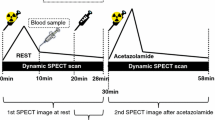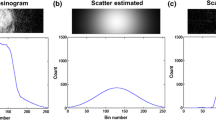Abstract
Purpose
Functional brain 99mTc-HMPAO single-photon emission computed tomography (SPECT) is a useful diagnostic tool for assessment of regional cerebral blood flow, particularly in dementia, cerebrovascular disease and epilepsy. Currently, the European and American Association of Nuclear Medicine Procedure Guidelines for Brain Perfusion SPET using 99mTc-labeled Radiopharmaceuticals recommend a time delay of 90 min between injection of 99mTc-HMPAO and data acquisition. This time delay is difficult to comply within the daily routine and present a problem, particularly with the elderly or demented patients. This study investigates in patients with perfusion deficits and in healthy subjects if the quality of the SPECT image is affected by lowering the time delay between 99mTc-HMPAO injection and data acquisition to 30 or 60 min.
Methods
Thirty-seven healthy subjects (17 females; mean age 65; range 42–84 years) with normal cerebral blood flow distribution and 31 patients (17 females; mean age 67; range 38–84) with reduced rCBF distribution were included. Images were obtained with a three-headed Philips IRIX SPECT scanner with high-resolution collimators. The healthy subjects were scanned 30, 60 and 90 min after 99mTc-HMPAO injection, and the patients were scanned 30 and 90 or 60 and 90 min after 99mTc-HMPAO injection. For evaluation of differences between the images obtained at various time points after injection, two different methods were used. The z-map method was used to subtract images from each other prior to visual inspection. In addition, principal component analysis was used as a quantitative analysis of the similarity of the images.
Results
Visual inspection of the subtracted images (30 or 60 versus 90 min) revealed that there was no spatial bias. Quantitatively, the average proportion of the total variance explained by the first principal component was 99.5% (range 98.9–99.6) for the healthy subjects and 99.4% (range 98.5–99.8) for the patients.
Conclusion
The time delay from injection of 99mTc-HMPAO to the start of the SPECT data acquisition can be reduced from 90 to 30 min without any significant impact on the quality of the acquired image.




Similar content being viewed by others
Reference
Catafau A. Brain SPECT in clinical practice. Part 1: perfusion. J Nucl Med 2001;42(2):259–71.
Camargo E. Brain SPECT in neurology and psychiatry. J Nucl Med 2001;42(4):611–23.
Neirinckx RD, Canning LR, Piper IM, Nowotnik DP, Pickett RD, Holmes RA, et al. Technetium-99-m d,l-HM-PAO: a new radiopharmaceutical for SPECT imaging of regional cerebral blood perfusion. J Nucl Med 1987;28(2):191–202.
Andersen AR, Friberg H, Schmidt J, Hasselbalch SG. Quantitative measurements of cerebral blood flow using SPECT and [99mTc]-d,l-HM-PAO compared to Xenon-133. J Cereb Blood Flow Metab 1988;8(6):69–81.
Tatsch K, Asenbaum S, Bernstein P, Catafau A, Halldin C, Pilowsky LS, et al. European Association of Nuclear Medicine procedure guidelines for brain perfusion SPET using (99m) Tc-labelled radiopharmaceuticals. Eur J Nucl Med Mol Imaging 2002;29(10):BP36–42.
Juni JE, Waxman AD, Devous MR Sr, Tikofsky RS, Ichise M, Van Heertum RL, et al. Procedure guideline for brain perfusion SPECT using technetium-99m radiopharmaceuticals. J Nucl Med 1998;39(5):923–6.
Woods RP, Cherry SR, Mazziotta JC. Rapid automated algorithm for aligning and reslicing PET images. J Comput Assist Tomogr 1992;16(4):620–33.
Boussion N, Houzard C, Ostrowsky K, Ryvlin P, Mauguiere F, Cinotti L. Automated detection of local normalization areas for ictal–interictal subtraction brain SPECT. J Nucl Med 2002;43:1419–25.
O’Brien TJ, So EL, Mullan BP, Hauser MF, Brinkmann BH, Jack CR, et al. Subtraction SPECT co-registered to MRI improves postictal SPECT localization of seizure foci. Neurology 1999;52(1):137–46.
O’Brien TJ, O’Connor MK, Mullan BP, Brinkmann BH, Hanson D, Jack CR, So El. Subtraction ictal SPET co-registered to MRI in partial epilepsy: description and technical validation of the method with phantom and patient studies. Nucl Med Commun 1998;19(1):31–45.
Andersson JLR. How to estimate global activity independent of changes in local activity. Neuroimage 1977;60:237–44.
Mardia KV, Kent JT, Bibby JM. Multivariate analysis. London: Academic; 1995. ISBN: 0-12-471252.
Trefethen LN, Bau D III. Numerical linear algebra. Philadelphia: SIAM; 1997. ISBN: 0-89871-487-7.
Demmel JW. Applied numerical linear algebra. Philadelphia: SIAM; 1997. ISBN: 0-89871-389-7.
Andersen AR, Friberg H, Lassen NA, Kristensen K, Neirinckx RD. Assessment of the arterial input curve for [99mTc]-d,l-HM-PAO by rapid octanol extraction. J Cereb Blood Flow Metab 1988;8(6):S23–30.
Ogasawara K, Ogawa A, Koshu K, Konno H, Suzuki M, Yoshimoto T. Hypofixation and hyperfixation of 99mTc-hexamethyl propyleneamine oxime in subacute cerebral infarction. J Nucl Med 2000;41:795–9.
Shimosegawa E, Hatazawa J, Inugami A, Fujita H, Ogawa T, Aizawa Y, et al. Cerebral infarction within six hours of onset: prediction of completed infarction with technetium-99m-HMPAO SPECT. J Nucl Med 1994;35:1097–103.
Baird AE, Austin MC, McKay WJ, Donnan GA. Sensitivity and specificity of 99mTc-HMPAO SPECT cerebral perfusion measurements during the first 48 hours for the localization of cerebral infarction. Stroke 1997;28:976–80.
Ichise M, Golan H, Ballinger JR, Vines D, Blackman A, Moldofsky H. Regional differences in technetium-99m-ECD clearance on brain SPECT in healthy subjects. J Nucl Med 1997;38:1253–60.
Lassen NA, Andersen AR, Friberg L, Paulson OB. The retention of [99mTc]-d,l-HM-PAO in the human brain after intracarotid bolus injection: a kinetic analysis. J Cereb Blood Flow Metab 1988;8:S13–22.
Acknowledgements
The authors thank Glenna Skouboe and Anita Dole for expert technical assistance. This study was supported by the Copenhagen Hospital Corporation, Technologist Foundation and the Danish Research Council.
The study was performed in accordance with the ethical standards of the Declaration of Helsinki and was approved by the ethical committee of Copenhagen and Frederiksberg (KF 02-050/01).
Author information
Authors and Affiliations
Corresponding author
Rights and permissions
About this article
Cite this article
Thomsen, G., de Nijs, R., Hogh-Rasmussen, E. et al. Required time delay from 99mTc-HMPAO injection to SPECT data acquisition: healthy subjects and patients with rCBF pattern. Eur J Nucl Med Mol Imaging 35, 2212–2219 (2008). https://doi.org/10.1007/s00259-008-0836-8
Received:
Accepted:
Published:
Issue Date:
DOI: https://doi.org/10.1007/s00259-008-0836-8




